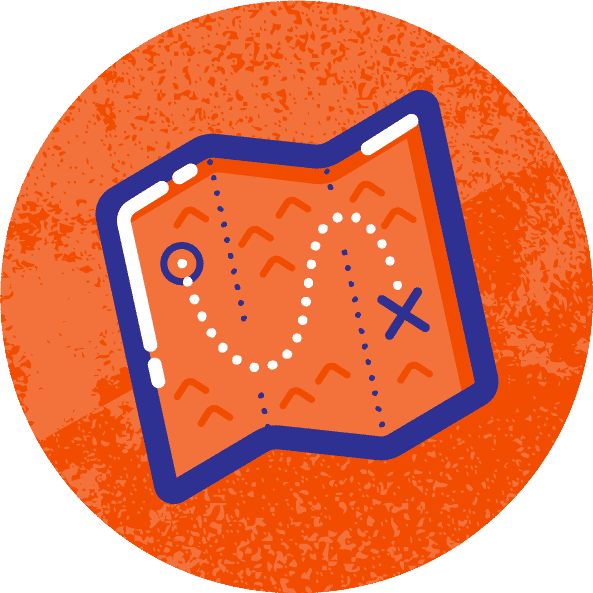A client reached out because he’s doing a strategic planning session with employees to plan for the coming year. He has run planning sessions as an employee in the past, but now it’s his own agency.
If you have the same question, I recommend approaching this in four parts—determine your plan, create the agenda, do the event, and work through followups.
Depending on your situation, consider doing a two-day strategic planning retreat; half a day to review progress this year, and 1.5 days to plan for next year. In this article, I’ve included a free one-day agenda.
Part I: Plan the Strategic Planning Retreat
Here’s how I organize the “planning the planning session” process:
- Define your goals for the event—what do you want to accomplish?
- Decide what’s up in the air vs. what’s nailed down. (That is, what are the items you’ll consider to be already-decided?)
- Make a list of topics you want to work out. These might involve brainstorming (generating ideas), discussion (making a decision on an idea), and/or workshopping (figuring out how to implement something you’ve decided to pursue).
- Put the topic list in priority order.
- Decide if you want to do an off-site, on-site, or virtual planning session. Off-site is often good for creative thinking and a change of pace, but you’ll need to weigh budget. And with the COVID-19 pandemic, you might lean toward 100% virtual.
- Choose the date(s) if options aren’t open-ended. Ideally, you should do the retreat during the work week, so you’re not requiring the team to give up their weekend.
- Decide what’s “must have” versus “nice to have” when it comes to outcomes.
- Create a draft agenda, with rough lengths per topic. For team bonding, be sure to include social time in addition to “work work work” time.
- See how long it is. It’s likely longer than it should be.
- Decide what to cut or collapse.
- Finalize the agenda and date. The agenda will drive the attendee list.
- Recruit someone on your team to manage logistics (booking the space, ordering food, scheduling calendar blocks, circulating the agenda and invitations, etc.).
- Invite the team, based on who needs to be there. People should clear their schedule for the retreat day(s)—and set up their Out of Office autoresponder.
- Send invitees a list of any prep they need to do beforehand (including notifying clients about availability).
- Pre-write a debrief survey to send after the retreat, assessing what did and didn’t work.
I recommend that you delegate logistics, but don’t delegate goal selection. It’s your retreat—make sure it serves your needs.
Part II: Build an Agenda [Free Template!]
Here’s a rough outline for a one-day retreat—the particulars will depend on what you need to brainstorm, discuss, and/or “workshop.” Try to limit sessions to 80 minutes apiece—or less, when it’s via video. When sessions are too long, people have trouble focusing… and that hurts productivity.
- Opening to Review Goals (with breakfast)
- Icebreaker (including learning about people beyond their work roles)
- Topic #1
- Short Break
- Topic #2
- Lunch Break
- Topic #3
- Distilling Outcomes into Next Steps
- Build List of Specific Actionables
- Happy Hour
Sprinkle breaks throughout. Instead of Topic #3, you might do overflow from Topic #2, or even spend all day on a single big topic.
You might consider a two-day retreat, especially if you’re doing the past-year review and the upcoming-year planning at the same time. In that case, you’ll also have more time for social activities. Be sure to allow time during Day 1 to complete “homework” for Day 2.
Consider whether sending “care packages” if people are meeting virtually. This creates a sense of togetherness when you can’t meet up in the same physical space.
Be sure to block-in “recovery” time for yourself the day after the retreat. You’ll use that to process followups and then catch up on what happened while you were away.
Part III: Hold the Retreat
Beforehand, be sure the food and venue are confirmed (if you’re meeting off-site), and remind people to activate their Out of Office messages.
Plan on this during the event:
- Use the agenda to stay on track, but be flexible if the team is following useful tangents.
- Be sure someone is recording key decisions and actionables. You may assign specific due dates later, but it’s important to track who’s on the hook for what.
- During lunch, double-check that you’re making progress toward your goals. If not, you’ll need to adjust in the afternoon.
Enjoy being away from the day-to-day—your retreat is still “work,” but it should be more fun than a regular day in the office.
Part IV: Work Through Followups
Afterwards, review key decisions and actionables. Identify what needs to happen next, including any open items. Circulate your post-retreat survey to the team to help you improve things next time.
Assign-out the followups, preferably using your regular PM system. You want followups to be part of everyone’s regular workflow. For you, try to focus on immediate followups before you get sucked back into the day-to-day. That’s why I recommended blocking-in time for followups after the retreat, instead of jumping into your regular schedule.
After all that, move forward with what you learned! The retreat alone isn’t enough to make everything happen, but getting out of the office will help you jumpstart the process.
Applying This at Your Agency
Have you scheduled your year-end retreat (to review progress from this year) or strategic planning retreat (to prepare for next year)? Now’s the time—it’ll be here before you expect it.
Want outside perspective on how to make the most of your retreat—or need a third-party facilitator who knows digital agencies? I’m glad to help. Contact me to see if there’s a fit.
Question: How do you approach year-end planning?


